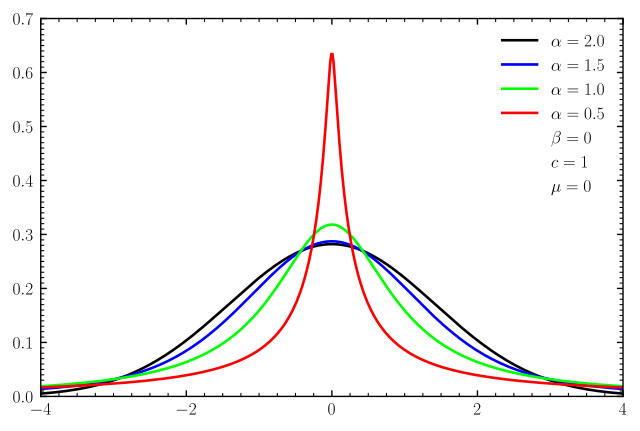< List of probability distributions > Holtsmark distribution
What is the Holtsmark distribution?
The Holtsmark distribution is a member of the Levy family and named after Norwegian physicist Johan Peter Holtsmark, who proposed the distribution as a model for fluctuating fields in plasma caused by chaotic motion of charged particles [1]. It has applications in astrophysics for the distribution of gravitational bodies and and plasma physics, where it can model the electric-microfield distribution involved in spectral line shapes [2].
Holtsmark distribution properties

The Holtsmark distribution is an one of few α-stable distributions with a closed form expression of a probability density function (pdf). However, the pdf is not expressible in terms of elementary functions; it can, however, be expressed in terms of hypergeometric functions [3] plus the Airy function of the second kind and its derivative [2].
![The PDF of the Holtsmark distribution expressed in terms of hypergeometric functions [3].](https://www.statisticshowto.com/wp-content/uploads/2023/08/holtsmark-distribution-pdf.png)
Modified Holtsmark distributions
While the Holtsmark distribution models the stationary probability distribution of a magnetic field, generated by moving charges of the plasma environment, a modified Holtsmark distribution can model a stationary probability distribution of force, acting on a charged particle in this environment, taking into account magnetic interaction [4].
Holtsmark’s original 1919 work took into account the total electrostatic field generated by all plasma particles. A simplified version of the distribution considers the “nearest neighbor” effect, because the force between two charged particles varies as the distance changes. The probability that a charged particle’s nearest neighbor, at distance r, is the probability that the biggest sphere with no other particles is of radius r. Assuming that this empty sphere with volume V follows a Poisson distribution g(V) = V0-1 exp (-V/V0), then the nearest neighbor probability g(r) of separation r is [5]

This induces a distribution W(F), with an infinite second moment, of force F given by
W(F)dF = g(V)dV
-
- with F(r) = q2/r2 and
- dF/dr = −2q2/r3.
References
[1] J. Holtsmark, Uber die Verbreiterung von Spektrallinien “The broadening of spectral lines”, Ann. Phys. (Leipzig) 58, 577-630 (1919).
[2] Eitanlees, CC BY-SA 4.0, via Wikimedia Commons
[3] W. H. Lee, Continuous and Discrete Properties of Stochastic Processes, PhD thesis (University of Nottingham, 2010), pp. 37-39 (citing T. M. Garoni, N. E. Frankel, “Lévy flights: Exact results and asymptotics beyond all orders”, Journal of Mathematical Physics 43 #5, 2670-2689 (2002)).
[4] Tymchyshyn, V. Internal magnetic field distribution in plasmas. Physics of Plasmas 26, 042120 (2019)
[5] Klages, R. et al. (2008). Anomalous Transport: Foundations and Applications. Wiley.